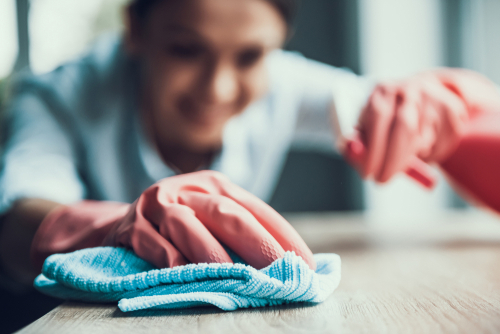Cleaning vs. Disinfecting: Why You Should Be Doing More of One Than the Other
In our efforts to combat the virus and keep our homes as germ-free as possible, many of us opt for strong chemical cleaners which contain bleach and acids as active ingredients.

The words ‘cleaning’ and ‘disinfecting’ are featuring more prominently in our conversations in the wake of the coronavirus pandemic. While these terms are used interchangeably, they mean different things and can produce very different outcomes.
Cleaning is the removal of germs and dirt from a surface. Cleaning does not kill germs; it removes them or reduces the number of germs, thereby lowering the risk of infection. Disinfecting is the process of using chemicals to kill germs using disinfectant cleaners.
Since the COVID-19 scare hit us, we have been repeatedly told to wash our hands with plain soap and water to get rid of germs. In a non-healthcare environment such as homes without COVID-19 patients, the same practice can help decontaminate high-touch surfaces. Scrubbing or brushing a surface with soap and water removes pathogens, dirt, debris and organic matter. In fact, as this Twitter thread explains, soap and water might do an even better job of protecting us from the virus than disinfecting wipes, antibacterial cleaners and alcohol-based sanitisers.
Contact with soapy water ruptures the lipid membrane enclosing the coronavirus, breaks down its structure and causes its insides to spill out. This kills the virus, rendering it useless. The scrubbing action dislodges it from our skin and washes it away.
Similarly, wiping down household surfaces such as switches, doorknobs, taps, kitchen counters, even electronics with soap and water is enough to keep them free of the virus and minimise your chances of infecting yourself when you touch them. Between cleaning two surfaces, make sure to rinse the towel or rag in order to avoid transferring the germs from one object to another.
As for what type of soap works best, in the case of COVID-19, it is just plain old soap, rather than any additive, that can destroy the virus. Any regular soap that produces lather when scrubbed is an effective weapon against the coronavirus. In fact, studies such as this one, have found that cleaning with antibacterial products is no more effective than regular soap.
For a disinfecting or an antibacterial product to be effective, it usually contains alcohol which, like soap, eliminates the virus. However, many products, including hand wash and hand sanitiser, claiming antibacterial properties contain triclosan – a potent chemical found in pesticides. In 2017, the FDA banned its use in hygiene products as evidence mounted of its link to antibiotic resistance in humans and its possible role as a hormone disruptor. It is, thus, important to read the labels on household cleaners and personal hygiene products so as to avoid inadvertently exposing ourselves to triclosan.
In our efforts to combat the virus and keep our homes as germ-free as possible, many of us opt for strong chemical cleaners which contain bleach and acids as active ingredients. Bleach is corrosive, and in high concentrations, can have toxic effects on human health. It irritates the lungs and can aggravate respiratory infections. The fumes from bleach-based cleaners waft through our homes, polluting indoor air and making us vulnerable to asthma. Washing masks with chlorine-based detergents can leave the chemical trapped in the fabric, leading to sneezing, nausea and vomiting.
Further, disinfectants and antibacterials are designed to kill all biological matter they come in contact with, including fungi, microbes and bacteria. They are indiscriminate in their destruction, killing the good and bad microorganisms present on human skin and household surfaces. This can be a problem since the human immune system is made stronger with exposure to a diverse variety of beneficial bacteria. Such exposure keeps our immune system on its toes and helps it protect us against allergies and ailments. This is especially true in the case of young children who benefit more from growing up in environments that are not completely sterile or germ-free.
From an environmental standpoint, disinfectants, since they are designed to destroy all categories of bacteria, are not biodegradable. This means that they continue to remain in the environment long after they flow out of our homes.
The Better Home cleaners contain naturally-derived surfactants that effectively remove debris, oil and organic matter. They contain plant-derived materials that break down dirt by degrading it at the source. Since they are free of acid, alcohol and bleach, they are biodegradable and can be safely washed into the soil and water bodies without fear of polluting them. They are also free of synthetic fragrances that pollute the air inside our homes and put us at risk of asthma, headaches and other respiratory illnesses. In the current situation, not only do they offer effective protection against the coronavirus but also protect the overall health, immunity and well-being of your family by freeing you from exposure to toxic chemicals.
This story made me
-
97
-
121
-
89
-
167
Tell Us More
If you found our story insightful, informative, or even just enjoyable, we invite you to consider making a voluntary payment to support the work we do at The Better India. Your contribution helps us continue producing quality content that educates, inspires, and drives positive change.
Choose one of the payment options below for your contribution-
By paying for the stories you value, you directly contribute to sustaining our efforts focused on making a difference in the world. Together, let's ensure that impactful stories continue to be told and shared, enriching lives and communities alike.
Thank you for your support. Here are some frequently asked questions you might find helpful to know why you are contributing?



















